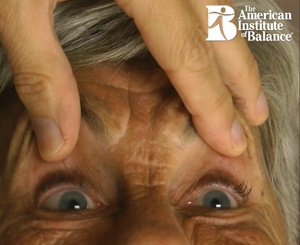
VIDEO – PC-BPPV Nystagmus: It’s not so rotary after all
Published on: September 6, 2013
In this video we see a strong and clear nystagmus consistent with a right ear (PC-BPPV Nystagmus: It’s not so rotary after all) PC-BPPV. The nystagmus, while described as “rotary-torsional”, will actually have a more visible upward and oblique movement than may be anticipated by new practitioners.
Often times, practitioners new to BPPV are perplexed when they begin see their first PC-BPPV patients after learning in their lectures about “rotary-torsional” nystagmus. It is important to remember Ewald’s 1st Law. Simply put, vertical canal BPPV produces vertical nystagmus. Posterior canal is upbeat, anterior canal (rare) downbeat, both with an oblique “twist” toward the ground. Also worth considering is the varying viscoelastic properties of the extra-ocular muscles. The rectus muscles are larger and stronger and the obliques, smaller and weaker. This often causes an earlier fatigue of the “rotary” aspect of the nystagmus but leaving the vertical component, which is rectus, dominated.
For a comprehensive discussion of eye movement, corresponding muscles and canal involvement see Roberts and Gans, Chapter 9, In Jacobson and Shephard (Eds.), Balance Function Assessment and Management, Plural, 2008.
Recent Posts
Comparison between Epley and Gans Repositioning Maneuvers for Posterior Canal BPPV: A Randomized Controlled Trial
Published on: March 26, 2024
Annals of Indian Academy of Neurology | Volume 26 – Issue 4 – July-August 2023 Benign paroxysmal positional vertigo (BPPV) is one of the commonly occurring causes of vertigo. BPPV […]
Read more
How to evaluate and treat the dizzy patient: non-medical diagnosis-based strategies
Published on: February 16, 2024
ENT & Audiology News | Balance & Vestibular Disorders 2024 It is estimated that dizziness, vertigo and falls are the third most common complaints heard by physicians from all age […]
Read more
The cost of untreated vestibular conditions: the role of otolaryngology & rehabilitation
Published on: February 15, 2024
Journal of Otolaryngology-ENT Research | Volume 16 Issue 1 – 2024 It is estimated that dizziness, vertigo, and falls are the third most common complaints heard by physicians from all […]
Read more
Understanding Mal de Debarquement syndrome (MdDS), persistent postural perceptual dizziness (3PD) and somatoform disorders: and the role of vestibular rehabilitation therapy (VRT)
Published on: January 3, 2024
Volume 16 Issue 1 – 2024 Richard E Gans, Kimberly Rutherford, Allisson D’Alessandro American Institute of Balance, USA Correspondence: Richard E Gans, Founder and Executive Director of the American Institute […]
Read more
